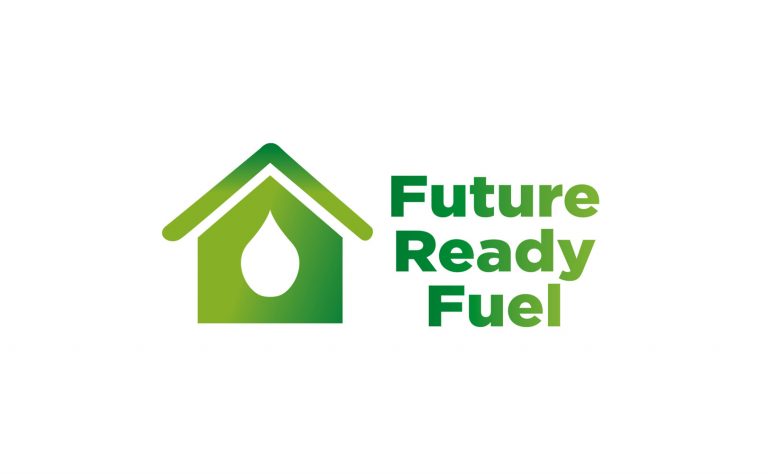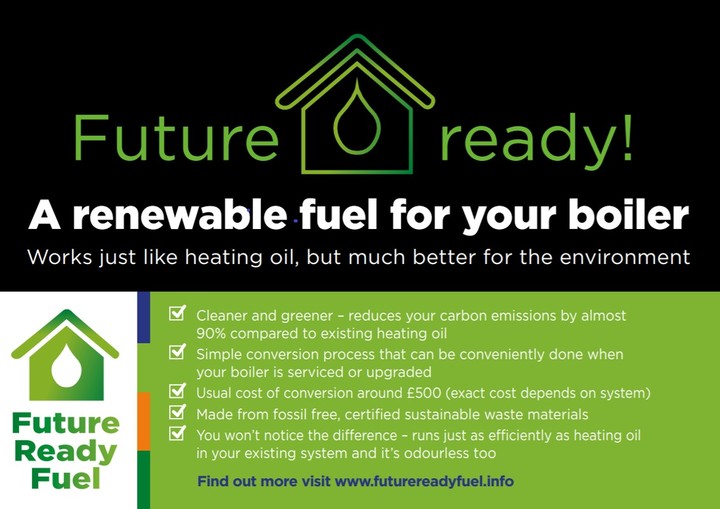
This is the final blog in the 3-part series of “Can you be GREEN with Oil?” blogs from GASSING IT UP. We hope it has been both enlightening & educational.
The content of these articles is accredited to the Future Ready Fuel campaign, which promotes Hydrotreated Vegetable Oil (HVO), a low-carbon liquid fuel made from waste fats and oils, as a viable, low-carbon alternative to kerosene for rural oil-heated homes.
The campaign, run by UKIFDA (the UK and Ireland Fuel Distributors Association) in conjunction with the trade association OFTEC (Oil Fired Technical Association), aims to provide information, conduct fuel trials, and demonstrate the technical feasibility and sustainability of HVO that offers a near 90% reduction in carbon emissions with minimal disruption to existing heating systems without requiring costly upgrades.
GASSING IT UP is very excited by the potential benefits of sustainable low-carbon renewable liquid fuels to off grid homeowners – not just to their homes and pockets but also to the environment – and wholeheartedly endorses the intent & objectives of the Future Ready Fuel campaign.
However, as before no more waffle, please explore & enjoy the content below and make your own mind up…
How is HVO made and is it sustainable?
HVO, is a renewable liquid fuel made from certified waste fats and oils and manufactured by a synthesised process with hydrogen to create a greener, cleaner fuel.
The ISCC (International Sustainability and Carbon Certification) confirms HVO is a sustainable fuel that is made from waste products or crops and doesn’t contribute to deforestation.
How will HVO support the UK’s net zero target?
Properties that convert from oil heating to HVO will immediately benefit from an 88% reduction in carbon emissions. This figure is based on the UK Government’s Standard Assessment Procedure (SAP 10.2) and is a consistent methodology for apportioning an equivalent carbon emission factor based upon common greenhouse gas emissions (GHG) from home heating fuels.
While we of course advocate for full decarbonisation where possible, it’s important to note that the term ‘net zero’ is not an absolute figure and it accounts for variation across the entire UK economy.
For example, it will be impossible to make some off-grid buildings suitable for zero carbon heating, while for others it may be feasible but not cost effective.
HVO allows almost any off-grid building to get very close to the target and can be seen both as a final solution or as a stepping stone, depending on the situation.
Does HVO contain palm oil?
Renewable liquid fuel is a globally produced and traded commodity and there is currently still palm in the supply chain. However, the development of stringent environmental and sustainability standards means this has diminished dramatically.
For example, a leading HVO producer has stated that palm feedstock accounts for only 5% of the HVO produced and none of this product is used in the UK or Europe. The UK Government’s own monitoring states that no palm product is used in imported HVO.
When will the new fuel be available?
We hope to introduce the new fuel in 2022, subject to the completion of successful trials and obtaining government approval to use HVO as a heating fuel. Our aim is to then enable existing oil heating users to convert to the new fuel gradually during the 2020s and 2030s.
Will HVO be more expensive?
Renewable solutions tend to be more expensive when they are first introduced to the market and HVO is no exception.
We are currently discussing with government how best to introduce the new fuel for heating and have proposed a similar price support model to one currently used for green road transport fuels.
This would ensure households are protected from excessive running costs. Once the HVO market is mature we expect prices to normalise and support should no longer be required.
Will there be enough HVO to meet demand?
Demand for renewable liquid fuels is increasing – and so is the supply of waste materials to manufacture them. Large quantities of biodiesel are already used in transport fuels and as electric vehicles become more common, the raw materials can be used to make HVO instead.
Production of HVO is forecast to rise by over 300% in Europe alone between 2020 and 2025 and expected to increase as fast, or even faster, elsewhere in the world. We have spoken to all of the main European and US HVO suppliers and they have confirmed that their plans to increase production would meet our requirements.
We are working with Government to ensure that there are clear policies in place to encourage supply as demand grows and reduce costs.
To what extent will the UK need to rely on imported fuel?
It is likely that the UK will always rely on imported fuel as there isn’t enough waste material available domestically to make all the fuel needed for the heating and transport markets. This is no different to the situation now with existing fuels.
However, government could introduce measures to improve UK waste capture and fuel production capacity which, for some fuel types, lags behind other countries in Europe.
Will HVO work with older applinaces and AGA’s?
Yes. Testing carried out so far suggests HVO will work with virtually any existing oil heating appliance once some simple modifications have been made.
In all cases the use of HVO will dramatically cut carbon emissions, but to achieve maximum carbon reduction, we recommend upgrading older appliances to a modern, high efficiency ‘A rated’ boiler. This is likely to save significantly on fuel and running costs.
Please note: HVO will not combust in a traditional vaporising sleeve burner that use wicks. The burner will need to be replaced with a ‘pot’ burner and the oil control valve recalibrated for the new fuel.
Can HVO be used in my existing tank?
Our trials to date suggest this is possible and there should be no reason why HVO cannot be stored in the tank you have, as long as it is well maintained.
We will be asking customers to reduce their kerosene levels to as low as possible before making the swap and may recommend having the inside of the tank cleaned as part of the conversion process.
As part of any swap from Kerosene to HVO we will be strongly recommending that HVO is not introduced to existing storage installations which do not have secondary containment and/or are over 20 years of age.
If you are transitioning from oil to HVO, it may be an ideal opportunity though for you to consider upgrading the tank in your garden and installing a bunded oil tank, which is a tank within a leak proof area or a double skinned oil tank. A bunded tank offers an extra layer of protection for homeowners against costly accidental oil spillages, theft, and environmental concerns.
I’m thinking of replacing my boiler, is it a good idea?
Changes to the way we heat our homes must happen if we are to achieve the net zero target. However, replacing an existing boiler should be a future-proof investment. Boilers can continue to be purchased until at least 2035 (see answer below), and we are confident that modern boilers will work efficiently with HVO. Conversion to the new fuel is expected to be straightforward and inexpensive.
It is also worth remembering that, even if you continue to use fossil fuels, updating your existing system with a high efficiency condensing boiler will almost certainly reduce your energy bills – and your emissions – often by a substantial amount.
Will oil burners be banned?
Former Prime Minister Rishi Sunak announced the proposals to ban the installation of new fossil fuel boilers in the home was being delayed from 2026 to 2035. The new Labour government has yet to outline its plans but, during the election campaign, they pledged to scrap this deadline. We are continuing to work with the new government and MPs to secure support for enabling oil heated homes to transition onto a renewable liquid fuel which we believe is a practical and affordable solution for many homes off the gas grid.
What modifications will I need to make to my oil boiler?
The process for converting existing oil boilers to HVO typically costs around £500 and includes removing fossil fuel residues, water and contaminates from the storage tank, replacing the burner with an HVO specific burner, changing nozzles, and ensuring that all fuel carrying components and seals are checked for compatibility.
Does HVO work in cold temperatures?
Yes. The fuel specification states that HVO remains operable in temperatures as low as -22°.
How can we help you?
If you would like to explore the feasibility of converting your current Kerosene-fuelled heating system to an HVO-fuelled heating system, please do not hesitate to contact us.
By choosing a trusted and registered local engineer, you’re not just protecting your home and keeping your heating system in top condition, you’re also supporting Whixley and the surrounding communities.

We highly recommend a visit the Future Ready Fuel website at www.futurereadyfuel.info/latest-news/ for the latest campaign news/progress.
Accreditation: The content in this article is accredited to the Future Ready Fuel campaign.
How can we help you?
If you would like to discuss any of the points raised in the article above please do not hesitate to contact us.
Remember, by choosing a trusted local engineer, you’re not just ‘Looking after your home, friends, and family’, you’re also supporting Whixley and surrounding communities.
Together, we can keep our friends and family safe, homes efficient, and our community strong.
Accreditation: This article is an output from Gas Safety Week 2025 and is reproduced courtesy of Gas Safe Register of which GASSING IT UP is a proud member.
